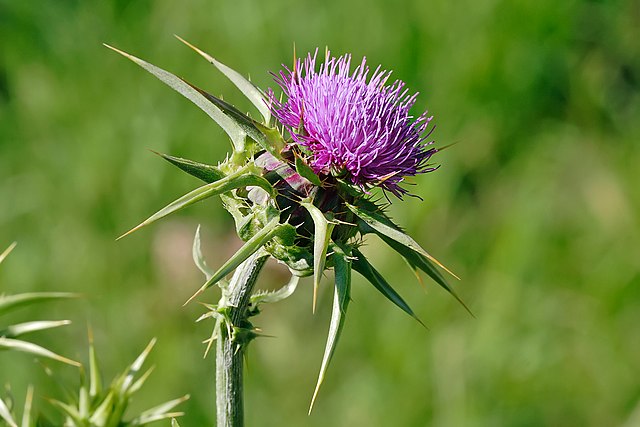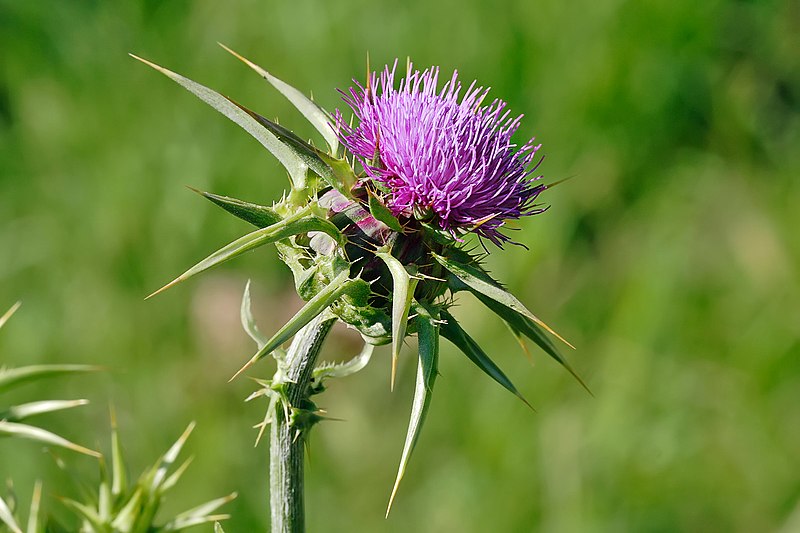Purple Thistle Flower: The Beauty And Brawn Of A Wildflower
The purple thistle flower is a beautiful and brawn wildflower that is found in many parts of the world. It is known for its spiky leaves and deep purple flowers, which can grow up to 6 inches in diameter. Purple thistles are often seen growing in meadows, fields, and along roadsides.
Main Content
Purple thistles are members of the Asteraceae family, which also includes daisies, sunflowers, and dandelions. They are herbaceous perennials, which means that they live for more than two years. Purple thistles typically grow to be about 3 feet tall, but some varieties can grow up to 6 feet tall. The leaves of the purple thistle are spiny and have a sharp, pointed tip. The flowers are purple or lavender in color and have a spiky center. Purple thistles bloom in the summer and fall.
Purple thistles are a valuable source of nectar for butterflies, bees, and other pollinators. They are also a host plant for several species of butterflies, including the painted lady and the little metalmark. The seeds of the purple thistle are eaten by birds and other animals.
Purple thistles are considered to be invasive weeds in some areas. They can spread quickly and crowd out native plants. However, purple thistles can also be beneficial plants. They can help to improve soil quality and attract pollinators.
Here are some of the benefits of purple thistles:
- They are a valuable source of nectar for butterflies, bees, and other pollinators.
- They are a host plant for several species of butterflies.
- The seeds of the purple thistle are eaten by birds and other animals.
- They can help to improve soil quality.
- They are a beautiful and unique wildflower.
If you are considering planting purple thistles in your garden, there are a few things you should keep in mind.
- Purple thistles can be invasive. Make sure to plant them in an area where they will not spread too quickly.
- Purple thistles can be prickly. Wear gloves when handling them.
- Purple thistles can attract unwanted pests, such as aphids and caterpillars. Be prepared to deal with these pests if they occur.
Conclusion
Purple thistles are beautiful and brawn wildflowers that can be beneficial to the environment. However, they can also be invasive. If you are considering planting purple thistles in your garden, be sure to do your research and plant them in an area where they will not spread too quickly.
Purple thistle flowers are a beautiful and unique sight to behold. With their deep purple petals and spiny leaves, they are sure to add a touch of elegance to any garden. But did you know that purple thistle flowers are also incredibly versatile? They can be used for a variety of purposes, from making natural remedies to attracting butterflies and other pollinators.
If you're interested in learning more about purple thistle flowers, I encourage you to visit Garden Wiki. This website has a wealth of information on the topic, including:
- The different types of purple thistle flowers
- How to grow and care for purple thistle flowers
- The medicinal properties of purple thistle flowers
- How to attract butterflies and other pollinators with purple thistle flowers
I think you'll find Garden Wiki to be a valuable resource for learning more about these fascinating flowers. So what are you waiting for? Visit Garden Wiki today!
FAQ of purple thistle flower
What is a purple thistle flower?
A purple thistle flower is a type of thistle that has purple petals. It is a member of the Asteraceae family, which also includes daisies, sunflowers, and dandelions. Purple thistle flowers are typically found in meadows, fields, and roadsides. They bloom in the summer and fall.
What are the benefits of purple thistle flowers?
Purple thistle flowers have a number of benefits. They are a good source of vitamins A and C, as well as fiber. They also contain antioxidants, which can help protect the body against damage from free radicals. Purple thistle flowers have been used medicinally for centuries to treat a variety of ailments, including stomachache, constipation, and high blood pressure.
How to plant purple thistle flowers?
Purple thistle flowers can be planted in the fall or spring. They prefer full sun and well-drained soil. To plant, sow the seeds 1/4 inch deep and 12 inches apart. Water regularly, especially during the first growing season. Purple thistle flowers will bloom in the second year.
How to care for purple thistle flowers?
Purple thistle flowers are relatively low-maintenance plants. They need regular watering, especially during hot, dry weather. They also benefit from a light application of fertilizer in the spring. Purple thistle flowers are not susceptible to many pests or diseases. However, they may be affected by aphids or spider mites. If you see any pests, you can treat them with insecticidal soap or neem oil.
How to harvest purple thistle flowers?
Purple thistle flowers can be harvested when they are in full bloom. To harvest, simply cut the stems just below the flower head. You can use the flowers fresh or dry them for later use.
Image of purple thistle flower
5 different images of "purple thistle flower" from Pinterest:
- A close-up of a single purple thistle flower with its sharp spines and fluffy purple petals.

- A field of purple thistle flowers in bloom, swaying in the wind.

- A purple thistle flower with a bee nectaring from it.

- A purple thistle flower with a butterfly resting on it.

- A purple thistle flower with its seed head, which is covered in tiny purple bristles.

Post a Comment for "Purple Thistle Flower: The Beauty And Brawn Of A Wildflower"